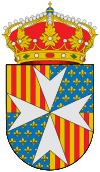Villanueva de Sigena facts for kids
Quick facts for kids
Villanueva de Sigena
|
||
|---|---|---|
| Villanueva de Sigena | ||
|
||
| Country | ||
| Autonomous community | ||
| Province | Huesca | |
| Comarca | Monegros | |
| Area | ||
| • Total | 146.37 km2 (56.51 sq mi) | |
| Elevation | 230 m (750 ft) | |
| Population
(2018)
|
||
| • Total | 394 | |
| • Density | 2.692/km2 (6.972/sq mi) | |
| Time zone | UTC+1 (CET) | |
| • Summer (DST) | UTC+2 (CEST) | |
| Postal code |
22231
|
|
Villanueva de Sigena is a small town in Spain. It is located in the Los Monegros area, which is in the northern part of the Huesca province. This province is part of the Aragon region. The town is close to the Alcanadre river. Most of the local economy comes from farming.
Important Places in Villanueva de Sigena
Villanueva de Sigena is home to some very old and important places. These include a famous monastery and a museum dedicated to a historical figure.
The Royal Monastery of Santa María de Sigena
On the edge of town, you will find the Royal Monastery of Santa María de Sigena. This is a very old and important religious building. Nearby, there is a hill called Mount Sigena. It is part of the Sierra de Alcubierre mountain range.
Michael Servetus: A Famous Scientist
Villanueva de Sigena is the birthplace of a famous doctor and thinker named Michael Servetus. He lived from about 1511 to 1553. Servetus made an important discovery about how blood moves in the body. He was the first to describe how blood flows from the heart to the lungs and back. This is called pulmonary circulation.
Today, you can visit a museum in the very house where Servetus was born. The Michael Servetus Institute runs this museum. It helps people learn about his life and his amazing scientific work.
The Old Convent of Santa María la Real de Sijena
Close to the town is the original settlement. It grew up around the old convent of Santa María la Real de Sijena. This convent was once very rich and important. It was founded in 1183 by Queen Sancha of Castile, who was the Queen of Aragon.
History and Restoration of the Convent
Sadly, much of the convent was badly damaged by fire in 1936. This happened during the Spanish Civil War. After the war, the convent was slowly restored. Nuns have lived there again since 1985.
Royal Burials at the Convent
Several kings and queens were buried in the convent's church. Queen Sancha, who founded the convent, died there and was buried within its walls. Her son, Pedro II of Aragon, and two of his sisters were also buried there.
Amazing Romanesque Frescoes
The convent's chapter house once held very important Romanesque frescoes. These were large paintings on walls, made around the year 1200. They were painted by artists who likely came from England. Some of these artists might have also worked on the famous Winchester Bible.
The Fate of the Frescoes
It is believed that the artists also visited Palermo before coming to Sigena. This is because some of the art shows influences from mosaics found there. Sadly, these beautiful frescoes were destroyed in the 1936 fire. Luckily, they had been fully photographed in black and white just before their destruction.
The damaged parts that remain have mostly lost their color. They are now kept in the Museu Nacional d'Art de Catalunya in Barcelona.
See also

- In Spanish: Villanueva de Sigena for kids



